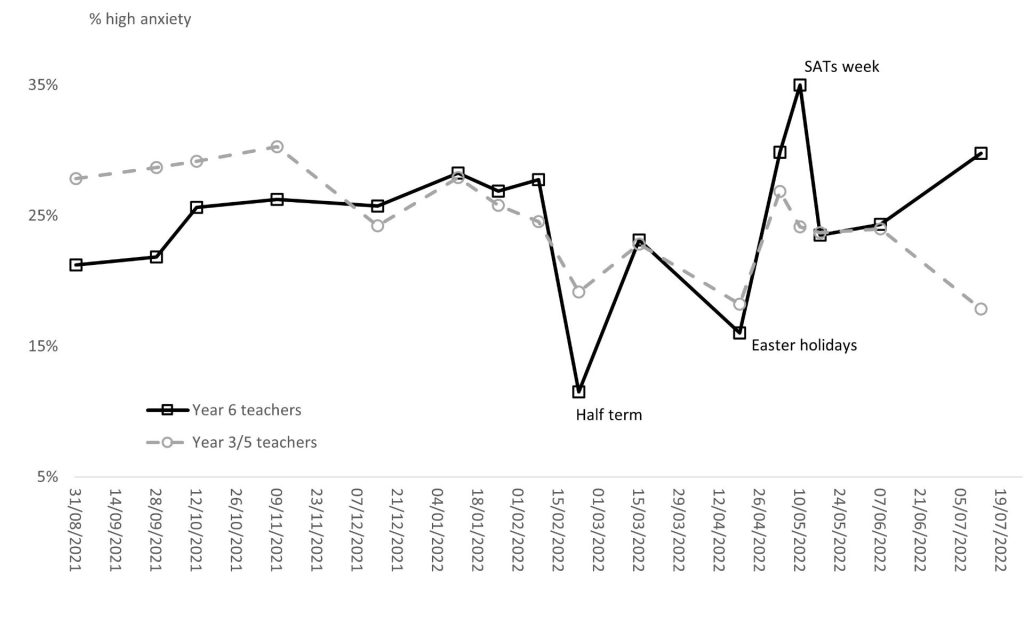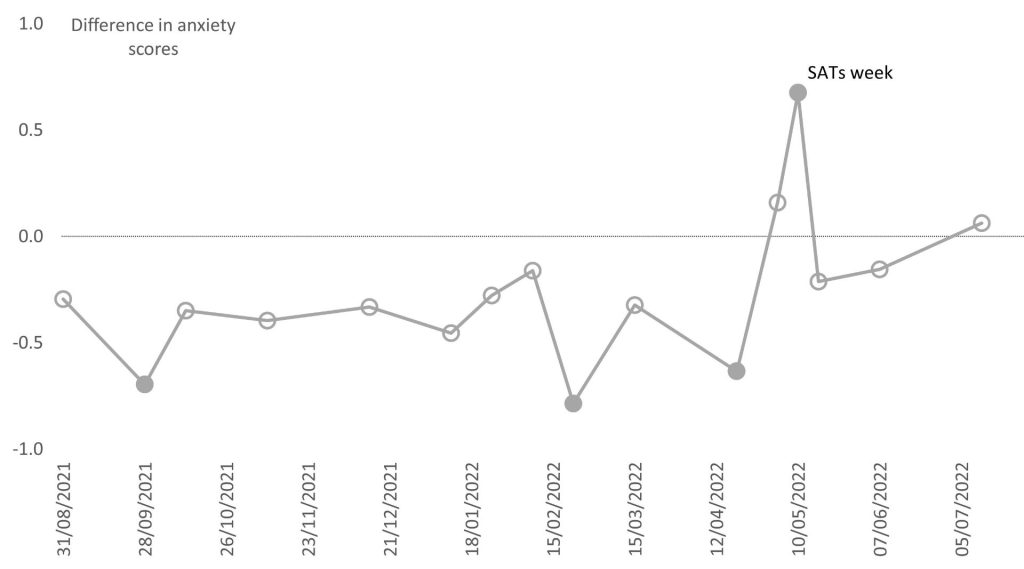The link between the Key Stage 2 SATs and teachers’ anxiety levels
By Blog Editor, IOE Digital, on 9 May 2023

Credit: Phil Meech for UCL.
9 May 2023
By John Jerrim
For quite a long time now, some groups have argued for the abolition of the Year 6 SATs (Standard Assessment Tests). Those who do so argue that they lead to a narrowing of the curricula, encourage schools to “teach to the test” and harm wellbeing across the education sector.
On this final point, in a previous blog I have discussed how evidence of a negative impact of the SATs on pupil wellbeing is pretty thin.
But what about the link between the SATs and the wellbeing of teachers? In a new academic working paper released today I take a look…
Which teachers are the SATs the most and least likely to affect?
It is likely that not all teachers are equally affected by the SATs; some will be much more exposed to the pressure they bring than others.
Those teaching Year 6 pupils – who are preparing them to take the tests – are likely to be at the sharp end of things.
On the other hand, the direct pressure the SATs put upon primary teachers outside of those teaching Year 6 classes is less clear. For instance, teachers providing instruction to Year 3 or Year 5 classes are likely to be particularly good comparators, given that no national assessments are taken during these school years[1].
Of course, such comparisons are not perfect. Not least because headteachers may select certain teachers to teach Year 6 classes to improve their SATs results. This can actually be seen in our data; Year 6 teachers tend to be more senior and more experienced than their Year 3/5 counterparts (see Table 1 below).
It is, nevertheless, still interesting to investigate what the patterns for these two comparison groups show.
Table 1. Who teaches Year 3/5 and Year 6 classes?
| Year 3/5 | Year 6 | |
| Job role | ||
| Class teacher | 51% | 26% |
| Middle leader | 28% | 33% |
| Senior Leadership Team | 19% | 33% |
| Headteacher | 2% | 7% |
| Experience | ||
| Under 5 years | 29% | 16% |
| 5 to 10 years | 23% | 27% |
| 10 to 20 years | 28% | 36% |
| Over 20 years | 20% | 21% |
Notes: Figures refer to column percentages. Year 3/5 n=327; Year 6 n=613. Source: TeacherTapp.
What does the comparison show?
At 16 points during the 2021/22 academic year we asked the TeacherTapp panel the following question about their anxiety at work:
“On a scale where 0 is ‘not at all anxious’ and 10 is ‘completely anxious’, overall, how anxious did you feel about work today?”
This included the week before, during and after the SATs took place.
The percent of Year 6 and Year 3/5 teachers who reported having high levels of work-related anxiety (a score of seven or more) is plotted in Figure 1.

Figure 1: The percent of Year 6 and Year 3/5 teachers highly anxious about work during the 2021/22 academic year.
Throughout most of the academic year, Year 6 teachers do not seem to be more anxious than those teaching Year 3 or Year 5 pupils. If anything, their anxiety levels are a little lower.
There is one clear exception though – the week that the SATs take place. The percent of highly anxious Year 6 teachers jumps from around 25% during most of the year up to 35% during the SATs week. However, once the test week is over, their anxiety quickly returns to “normal” levels.
Figure 2 presents similar results, but now focusing on differences in average anxiety scores controlling for differences in the background characteristics of Year 3/5 and Year 6 teachers. Again, the teachers most exposed to the pressures of the SATs are generally no more anxious about work than primary teachers with less direct exposure – including in the weeks leading up to the tests. But – during the week the SATs take place – the anxiety levels of Year 6 teachers clearly increases.

Figure 2. Difference in conditional work-related anxiety scores of Year 6 and Year 3/5 teachers during the 2021/22 academic year.
Notes: Figures refer to the difference in work-related anxiety between Year 6 teachers and Year 3/5 teachers. Positive figures are where Year 6 teachers report higher levels of work-related anxiety than Year 3/5 teachers. Circular markers with solid fill illustrate where the difference is statistically significant at the five percent level (hollow markers indicate where the difference is not statistically significant).
A short, sharp – but temporary – increase
What, then, should we make of these results?
On the one hand, I think they do provide some clear evidence that the SATs have some negative impact on the anxiety levels of teachers who bear most responsibility for the results.
Yet, at the same time, the impact also seems to be relatively short-lived. It does not seem to be the case that Year 6 teachers are more anxious about work than their colleagues throughout the academic year, or even in the period building up to the tests. Rather, they suffer a short, sharp increase to their anxiety levels when the tests are taking place.
How big a problem is this? Personally, I am not too sure. We all suffer from stressful periods at work – just ask accountants at the end of the financial year or those working for the emergency services on a Friday or Saturday night.
Then again, I appreciate I am not a Year 6 teacher, and don’t have to suffer this stressful week myself.
[1] Year 1 students have a phonics screening test, Year 2 pupils the Key Stage 1 SATs and Year 4 pupils the multiplication tables check. These are all much lower stakes assessments for teachers and schools than the Year 6 SATs. However, to get the cleanest possible comparator group, we focus on teachers of Year 3 and Year 5 pupils when no national assessments take place.
This post was previously published on the FFT Education Datalab blog.
 Close
Close



